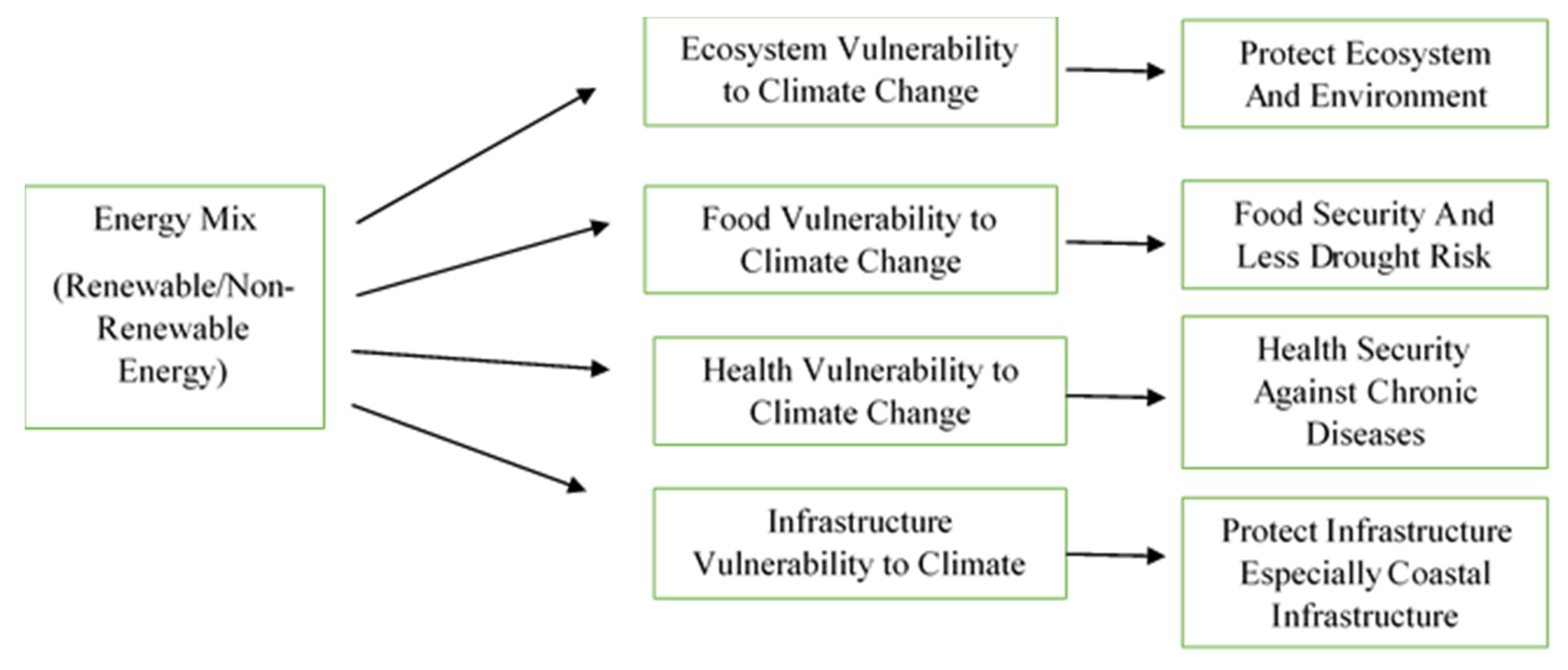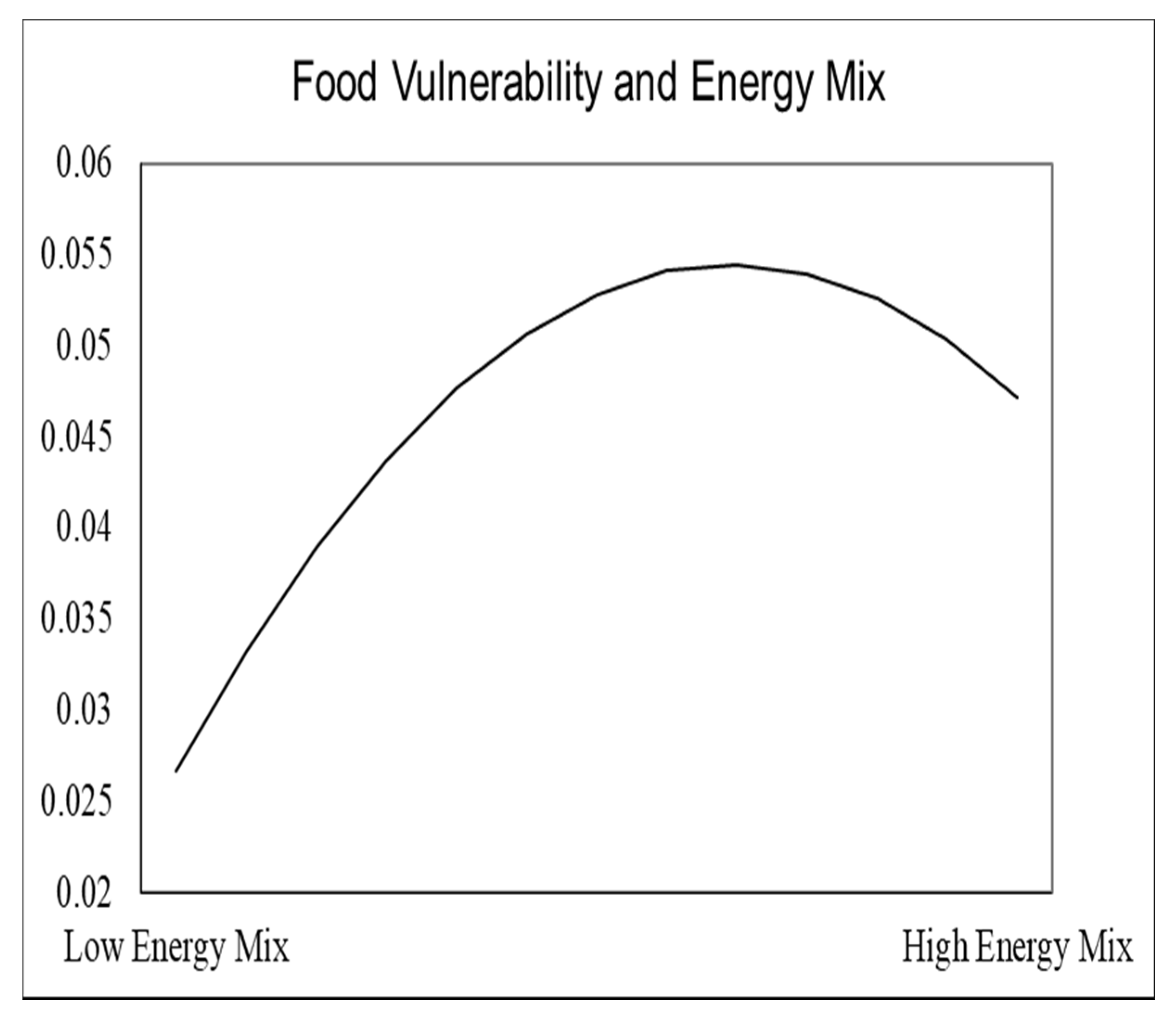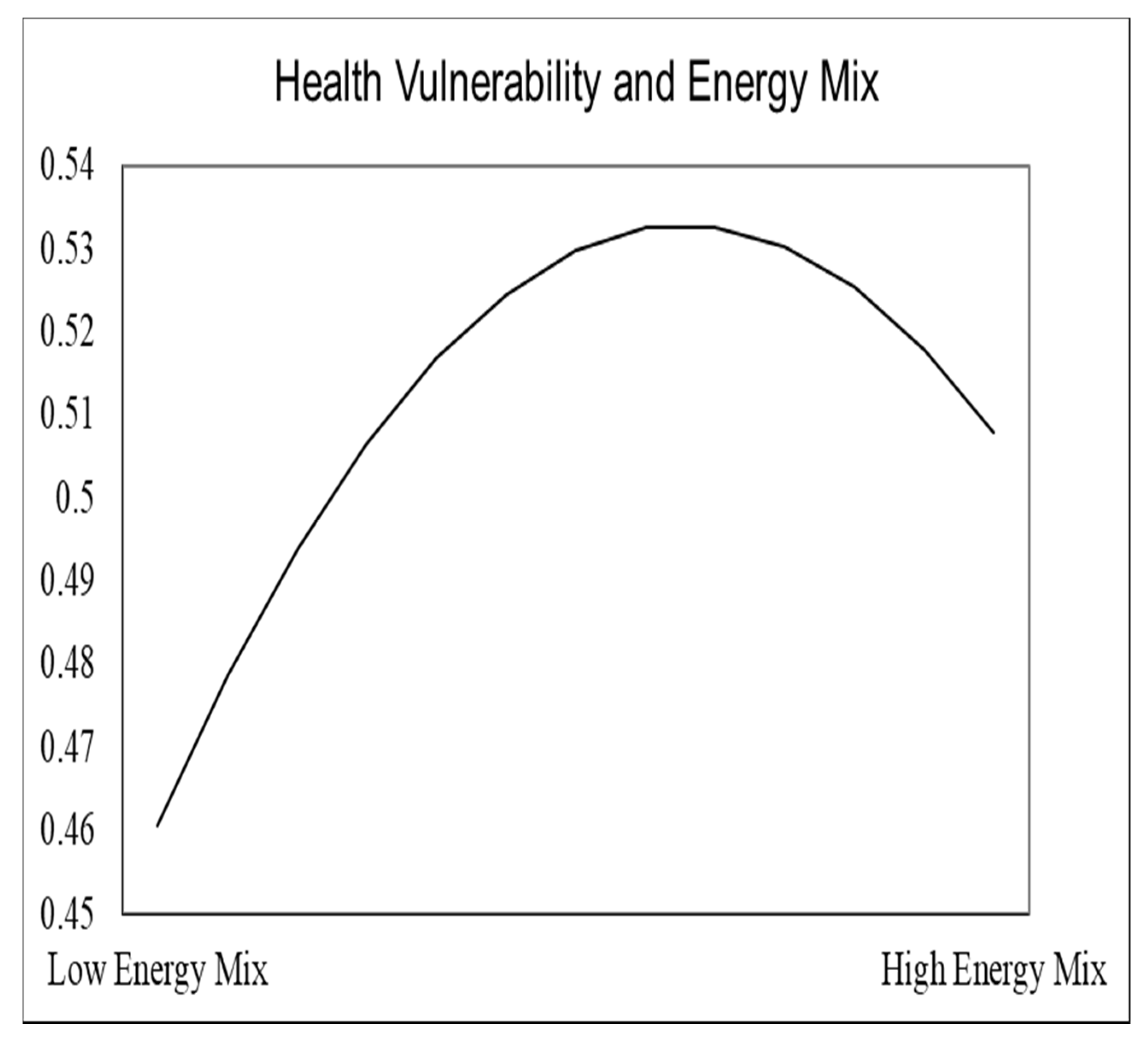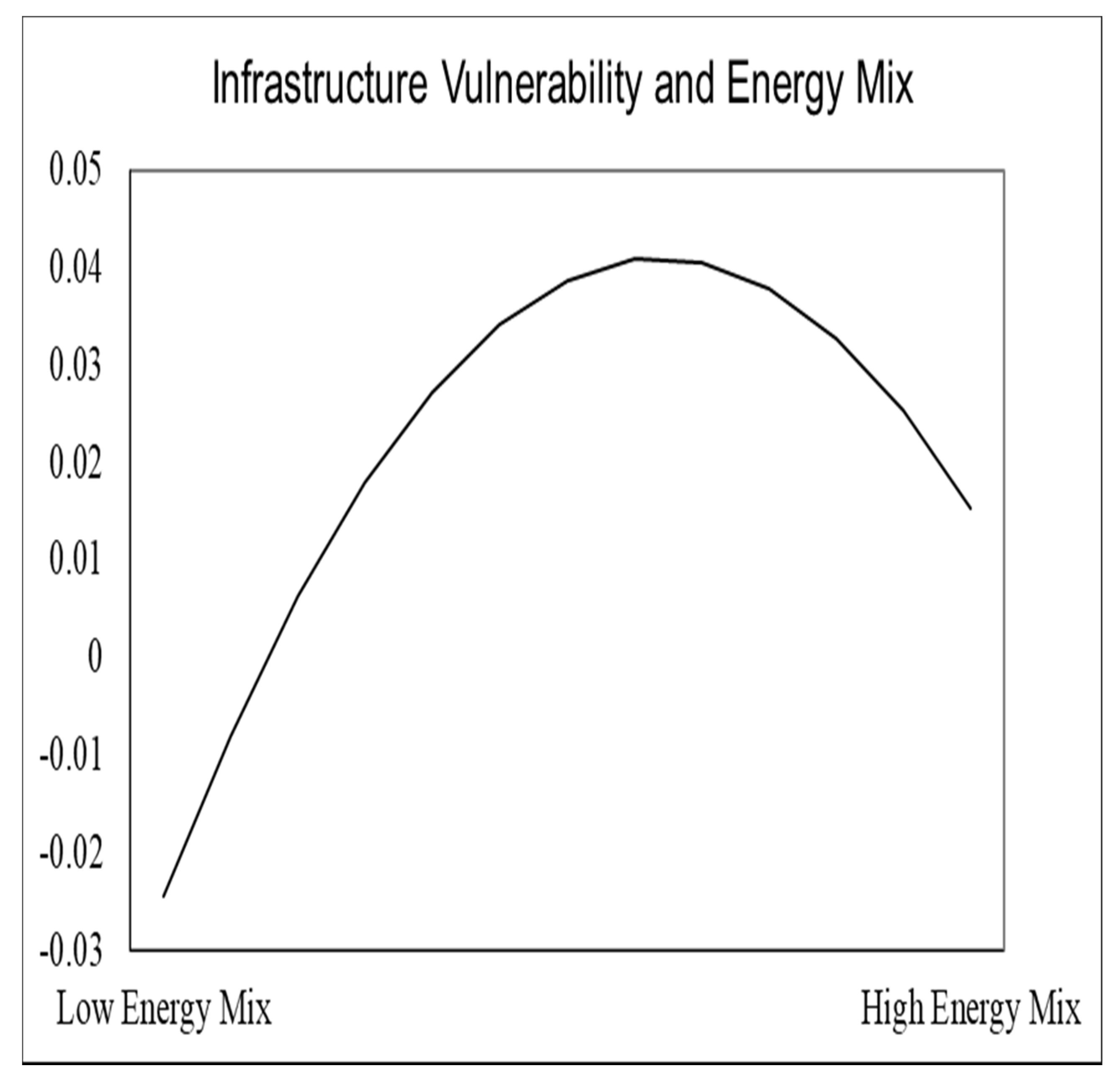Role of Energy Mix in Determining Climate Change Vulnerability in G7 Countries
Abstract
:1. Introduction
2. Literature Review
3. Methodology
3.1. Theoretical Framework
3.2. Data Source
3.3. Model Specification
3.4. Estimation Technique
4. Results Discussion
5. Conclusions and Policy Recommendations
Author Contributions
Funding
Institutional Review Board Statement
Informed Consent Statement
Data Availability Statement
Acknowledgments
Conflicts of Interest
Abbreviations
| ARDL | Autoregressive distributed lag model |
| G7 | The Group of Seven (G7) is an inter-governmental political forum consisting of Canada, France, Germany, Italy, Japan, the United Kingdom and the United States |
| GDP | Gross domestic product |
| WDI | World Development Indicator |
| CO2 | Carbon dioxide |
References
- Sheridan, S.C.; Allen, M.J. Temporal trends in human vulnerability to excessive heat. Environ. Res. Lett. 2018, 13, 043001. [Google Scholar] [CrossRef]
- Vulnerability to Climate Change and Reasons for Concern: A Synthesis. Available online: https://archive.ipcc.ch/ipccreports/tar/wg2/pdf/wg2TARchap19.pdf (accessed on 10 January 2022).
- Stocker, T.F.; Qin, D.; Plattner, G.-K.; Tignor, M.; Allen, S.K.; Boschung, J.; Nauels, A.; Xia, Y.; Bex, V.; Midgley, P.M. Climate Change 2013: The Physical Science Basis: Working Group I Contribution to the Fifth Assessment Report of the Intergovernmental Panel on Climate Change. Available online: https://www.ipcc.ch/site/assets/uploads/2017/09/WG1AR5_Frontmatter_FINAL.pdf (accessed on 10 January 2022).
- Pörtner, H.-O.; Roberts, D.C.; Masson-Delmotte, V.; Zhai, P. The Ocean and Cryosphere in a Changing Climate: A Special Report by the Intergovernmental Panel on Climate Change. Available online: https://www.ipcc.ch/srocc/ (accessed on 10 January 2022).
- Foidart, F.; Oliver-Solá, J.; Gasol, C.; Gabarrell, X.; Rieradevall, J. How important are current energy mix choices on future sustainability? Case study: Belgium and Spain—projections towards 2020–2030. Energy Policy 2010, 38, 5028–5037. [Google Scholar] [CrossRef]
- Mamkhezri, J.; Malczynski, L.; Chermak, J. Assessing the Economic and Environmental Impacts of Alternative Renewable Portfolio Standards: Winners and Losers. Energies 2021, 14, 3319. [Google Scholar] [CrossRef]
- Tobin, I.; Greuell, W.; Jerez, S.; Ludwig, F.; Vautard, R.; van Vliet, M.T.; Bréon, F.-M. Vulnerabilities and resilience of European power generation to 1.5 °C, 2 °C and 3 °C warming. Environ. Res. Lett. 2018, 13, 044024. [Google Scholar] [CrossRef]
- Abbasi, K.R.; Shahbaz, M.; Zhang, J.; Irfan, M.; Alvarado, R. Analyze the environmental sustainability factors of China: The role of fossil fuel energy and renewable energy. Renew. Energy 2022, 187, 390–402. [Google Scholar] [CrossRef]
- IEA Net Zero by 2050–Analysis. Available online: https://www.iea.org/reports/net-zero-by-2050 (accessed on 10 January 2022).
- IUCN Marine Life, Fisheries Increasingly Threatened as the Ocean Loses Oxygen–IUCN Report. Available online: https://www.iucn.org/news/marine-and-polar/201912/marine-life-fisheries-increasingly-threatened-ocean-loses-oxygen-iucn-report (accessed on 10 January 2022).
- Mamkhezri, J. Market and Non-Market Valuation of Renewable Energy. Available online: https://digitalrepository.unm.edu/econ_etds/106 (accessed on 10 January 2022).
- Mamkhezri, J.; Bohara, A.K.; Camargo, A.I. Air pollution and daily mortality in the Mexico City Metropolitan Area. 2020. Available online: http://www.scielo.org.mx/scielo.php?script=sci_arttext&pid=S0187-62362020000300249 (accessed on 10 January 2022).
- Perera, F. Pollution from fossil-fuel combustion is the leading environmental threat to global pediatric health and equity: Solutions exist. Int. J. Environ. Res. Public Health 2018, 15, 16. [Google Scholar] [CrossRef] [PubMed] [Green Version]
- Hardinge, P.; Kiddle, G.; Tisi, L.; Murray, J.A.H. Optimised LAMP allows single copy detection of 35Sp and NOSt in transgenic maize using Bioluminescent Assay in Real Time (BART). Sci. Rep. 2018, 8, 17590. [Google Scholar] [CrossRef]
- Cambridge University Press. IPCC, 2014: Climate Change 2014: Mitigation of Climate Change. Contribution of Working Group III to the Fifth Assessment Report of the Intergovernmental Panel on Climate Change; Edenhofer, R., Pichs-Madruga, Y., Sokona, E., Farahani, S., Kadner, K., Seyboth, A., Adler, I., Baum, S., Brunner, P., Eickemeier, B., Eds.; Cambridge University Press: Cambridge, UK; New York, NY, USA, 2015; ISBN 9781107058217. [Google Scholar]
- Kim, S.E.; Bell, M.L.; Hashizume, M.; Honda, Y.; Kan, H.; Kim, H. Associations between mortality and prolonged exposure to elevated particulate matter concentrations in East Asia. Environ. Int. 2017, 110, 88–94. [Google Scholar] [CrossRef]
- Grémillet, D.; Fort, J.; Amélineau, F.; Zakharova, E.; Le Bot, T.; Sala, E.; Gavrilo, M. Arctic warming: Nonlinear impacts of sea-ice and glacier melt on seabird foraging. Glob. Chang. Biol. 2015, 21, 1116–1123. [Google Scholar] [CrossRef] [Green Version]
- Hallegatte, S. Strategies to Adapt to an Uncertain Future. Glob. Environ. Chang. 2009, 19, 240–247. [Google Scholar] [CrossRef]
- Wang, J.; Hassan, M.S.; Alharthi, M.; Arshed, N.; Hanif, I.; Saeed, M.I. Inspecting non-linear behavior of aggregated and disaggregated renewable and non-renewable energy consumption on GDP per capita in Pakistan. Energy Strat. Rev. 2021, 39, 100772. [Google Scholar] [CrossRef]
- Towards an International Certificate System—The Stimulating Example of Belgium. Available online: https://www.researchgate.net/profile/Leonardo-Meeus/publication/228887691_Towards_an_international_certificate_system-the_stimulating_example_of_Belgium/links/00b7d52fe7e8bbb2de000000/Towards-an-international-certificate-system-the-stimulating-example-of-Belgium.pdf (accessed on 10 January 2022).
- Khan, I.; Hou, F.; Irfan, M.; Zakari, A.; Le, H.P. Does energy trilemma a driver of economic growth? The roles of energy use, population growth, and financial development. Renew. Sustain. Energy Rev. 2021, 146, 111157. [Google Scholar] [CrossRef]
- Zahid, T.; Arshed, N.; Munir, M.; Hameed, K. Role of energy consumption preferences on human development: A study of SAARC region. Econ. Plan. 2020, 54, 121–144. [Google Scholar] [CrossRef]
- Mamkhezri, J.; Thacher, A.J.; Chermak, M.J. Renewable Energy Projects: A Socioeconomic and Environmental Case Study for New Mexico.; Riding the Energy Cycles. In Proceedings of the 35th USAEE/IAEE North American Conference , Houston, TX, USA, 12–15 November 2017. [Google Scholar]
- Bloyd, D.I.; Bloyd, C.N. Renewable Energy and Sustainable Development: Lessons Learned from APEC for the Preparation of Rio+10. Asian Perspect. 2001, 25, 85–111. [Google Scholar] [CrossRef]
- Twerefou, D.K.; Danso-Mensah, K.; Bokpin, G.A. The environmental effects of economic growth and globalization in Sub-Saharan Africa: A panel general method of moments approach. Res. Int. Bus. Financ. 2017, 42, 939–949. [Google Scholar] [CrossRef]
- Abdelzaher, D.M.; Martynov, A.; Zaher, A.M.A. Vulnerability to climate change: Are innovative countries in a better position? Res. Int. Bus. Financ. 2019, 51, 101098. [Google Scholar] [CrossRef]
- Birkmann, J.; Jamshed, A.; McMillan, J.M.; Feldmeyer, D.; Totin, E.; Solecki, W.; Ibrahim, Z.Z.; Roberts, D.; Kerr, R.B.; Poertner, H.-O.; et al. Understanding human vulnerability to climate change: A global perspective on index validation for adaptation planning. Sci. Total Environ. 2021, 803, 150065. [Google Scholar] [CrossRef] [PubMed]
- International Trade and the Adaptation to Climate Change and Variability. Available online: http://www.vwl.unibe.ch/wp-content/uploads/papers/dp/dp1201.pdf (accessed on 10 January 2022).
- Holický, M.; Sýkora, M. Assessment of Flooding Risk to Cultural Heritage in Historic Sites. J. Perform. Constr. Facil. 2010, 24, 432–438. [Google Scholar] [CrossRef]
- Assessment of Cost of Sea-Level Rise in the Republic of Croatia Including Cost and Benefits of Adaptation. Available online: https://iczmplatform.org/storage/documents/7VBljfSyuHsN5HBfNuYgPUlBj3D2TIyZclgoJUMK.pdf (accessed on 10 January 2022).
- The G7 Climate Mandate and the Tregedy of Horizons. Available online: https://carnegieendowment.org/2016/02/04/g7-climate-mandate-and-tragedy-of-horizons-pub-62665 (accessed on 10 January 2022).
- Li, Y.; Yang, X.; Ran, Q.; Wu, H.; Irfan, M.; Ahmad, M. Energy structure, digital economy, and carbon emissions: Evidence from China. Environ. Sci. Pollut. Res. 2021, 28, 64606–64629. [Google Scholar] [CrossRef]
- BBC Climate Change: Ban New Gas Boilers from 2025 to Reach Net-Zero–BBC News. Available online: https://www.bbc.com/news/science-environment-57149059 (accessed on 10 January 2022).
- Gutermuth, P.-G. Financial measures by the state for the enhanced deployment of renewable energies. Sol. Energy 1998, 64, 67–78. [Google Scholar] [CrossRef]
- Irfan, M.; Ahmad, M. Relating consumers′ information and willingness to buy electric vehicles: Does personality matter? Transp. Res. Part D Transp. Environ. 2021, 100, 103049. [Google Scholar] [CrossRef]
- Razzaq, A.; Ajaz, T.; Li, J.C.; Irfan, M.; Suksatan, W. Investigating the asymmetric linkages between infrastructure development, green innovation, and consumption-based material footprint: Novel empirical estimations from highly resource-consuming economies. Resour. Policy 2021, 74, 102302. [Google Scholar] [CrossRef]
- Chen, C.; Noble, I.; Hellmann, J.; Coffee, J.; Murillo, M.; Chawla, N. University of Notre Dame Global Adaptation Index. Available online: https://gain.nd.edu/our-work/country-index/ (accessed on 10 January 2022).
- Gritti, E.S.; Smith, B.; Sykes, M.T. Vulnerability of Mediterranean Basin ecosystems to climate change and invasion by exotic plant species. J. Biogeogr. 2005, 33, 145–157. [Google Scholar] [CrossRef]
- Vázquez-Rowe, I.; Reyna, J.L.; García-Torres, S.; Kahhat, R. Is climate change-centrism an optimal policy making strategy to set national electricity mixes? Appl. Energy 2015, 159, 108–116. [Google Scholar] [CrossRef]
- Wen, C.; Akram, R.; Irfan, M.; Iqbal, W.; Dagar, V.; Acevedo-Duqued; Saydaliev, H.B. The asymmetric nexus between air pollution and COVID-19: Evidence from a non-linear panel autoregressive distributed lag model. Environ. Res. 2022, 209, 112848. [Google Scholar] [CrossRef]
- Yildiz, I. Review of climate change issues: A forcing function perspective in agricultural and energy innovation. Int. J. Energy Res. 2019, 43, 2200–2215. [Google Scholar] [CrossRef]
- Elum, Z.; Momodu, A.S. Climate change mitigation and renewable energy for sustainable development in Nigeria: A discourse approach. Renew. Sustain. Energy Rev. 2017, 76, 72–80. [Google Scholar] [CrossRef]
- Mamkhezri, J.; Thacher, J.A.; Chermak, J.M. Consumer Preferences for Solar Energy: A Choice Experiment Study. Energy J. 2020, 41. [Google Scholar] [CrossRef]
- .Mamkhezri, J.; Thacher, J.A.; Chermak, J.M.; Berrens, R.P. Does the solemn oath lower WTP responses in a discrete choice experiment application to solar energy? J. Environ. Econ. Policy 2020, 9, 447–473. [Google Scholar] [CrossRef]
- Fang, Z.; Razzaq, A.; Mohsin, M.; Irfan, M. Spatial spillovers and threshold effects of internet development and entrepreneurship on green innovation efficiency in China. Technol. Soc. 2021, 68, 101844. [Google Scholar] [CrossRef]
- Tanveer, A.; Zeng, S.; Irfan, M.; Peng, R. Do Perceived Risk, Perception of Self-Efficacy, and Openness to Technology Matter for Solar PV Adoption? An Application of the Extended Theory of Planned Behavior. Energies 2021, 14, 5008. [Google Scholar] [CrossRef]
- Javaid, A.; Arshed, N.; Munir, M.; Zakaria, Z.A.; Alamri, F.S.; Khalifa, H.A.E.-W.; Hanif, U. Econometric Assessment of Institutional Quality in Mitigating Global Climate-Change Risk. Sustainability 2022, 14, 669. [Google Scholar] [CrossRef]
- Salem, S.; Arshed, N.; Anwar, A.; Iqbal, M.; Sattar, N. Renewable Energy Consumption and Carbon Emissions—Testing Nonlinearity for Highly Carbon Emitting Countries. Sustainability 2021, 13, 11930. [Google Scholar] [CrossRef]
- Muhammad, A.A.; Arshed, N.; Kousar, N. Renewable Energy Consumption and Economic Growth in Member of OIC Countries. Eur. Online J. Nat. Soc. 2017, 6, 111–129. [Google Scholar]
- Walther, G.-R.; Post, E.; Convey, P.; Menzel, A.; Parmesan, C.; Beebee, T.J.C.; Fromentin, J.-M.; Hoegh-Guldberg, O.; Bairlein, F. Ecological responses to recent climate change. Nature 2002, 416, 389–395. [Google Scholar] [CrossRef] [PubMed]
- Kopp, R.E.; Horton, R.M.; Little, C.M.; Mitrovica, J.X.; Oppenheimer, M.; Rasmussen, D.J.; Strauss, B.H.; Tebaldi, C. Probabilistic 21st and 22nd century sea-level projections at a global network of tide-gauge sites. Earth Future 2014, 2, 383–406. [Google Scholar] [CrossRef]
- Watts, N.; Adger, W.N.; Agnolucci, P.; Blackstock, J.; Byass, P.; Cai, W.; Chaytor, S.; Colbourn, T.; Collins, M.; Cooper, A. Health and Climate Change: Policy Responses to Protect Public Health. Lancet 2015, 386, 1861–1914. [Google Scholar] [CrossRef]
- Mamkhezri, J.; Torell, G.L. Assessing the Impact of Exceptional Drought on Emissions and Electricity Generation: The Case of Texas. Energy J. 2022, 43. [Google Scholar] [CrossRef]
- Swart, R.; Raes, F. Making integration of adaptation and mitigation work: Mainstreaming into sustainable development policies? Clim. Policy 2007, 7, 288–303. [Google Scholar] [CrossRef]
- Tol, R.S.J.; Klein, R.J.T.; Nicholls, R.J. Towards Successful Adaptation to Sea-Level Rise along Europe′s Coasts. J. Coast. Res. 2008, 242, 432–442. [Google Scholar] [CrossRef] [Green Version]
- Lemmen, D.S.; Warren, F.J. Climate Change Impacts and Adaptation: A Canadian Perspective. 2004. Available online: https://d1ied5g1xfgpx8.cloudfront.net/pdfs/27428.pdf (accessed on 10 January 2022).
- Pao, H.-T.; Tsai, C.-M. CO2 emissions, energy consumption and economic growth in BRIC countries. Energy Policy 2010, 38, 7850–7860. [Google Scholar] [CrossRef]
- Arshed, N.; Anwar, A.; Kousar, N.; Bukhari, S. Education Enrollment Level and Income Inequality: A Case of SAARC Economies. Soc. Indic. Res. 2017, 140, 1211–1224. [Google Scholar] [CrossRef]
- Hassan, M.S.; Meo, M.S.; Karim, M.Z.A.; Arshed, N. Prospects of Environmental Kuznets Curve and Green Growth in Developed and Developing Economies. Stud. Appl. Econ. 2020, 38. [Google Scholar] [CrossRef]
- Pesaran, M.H.; Shin, Y.; Smith, R.P. Pooled Mean Group Estimation of Dynamic Heterogeneous Panels. J. Am. Stat. Assoc. 1999, 94, 621–634. [Google Scholar] [CrossRef]
- Karimi, M.S.; Khezri, M.; Khan, Y.A.; Razzaghi, S. Exploring the influence of economic freedom index on fishing grounds footprint in environmental Kuznets curve framework through spatial econometrics technique: Evidence from Asia-Pacific countries. Environ. Sci. Pollut. Res. 2021, 29, 6251–6266. [Google Scholar] [CrossRef]





| No | Model | |
|---|---|---|
| 1 | Ecosystem Vulnerability | ESVit = α0 + β1 EMit + β2 EM2it + β3 logTOit + β4 logEXPit + β5 logINDit + µit |
| 2 | Food Vulnerability | FDVit = α0 + β1 EMit + β2 EM2it + β3 logTOit + β4 logEXPit + β5 logINDit + µit |
| 3 | Health Vulnerability | HEVit = α0 + β1 EMit + β2 EM2it + β3 logTOit + β4 logEXPit + β5 logINDit + µit |
| 4 | Infrastructure Vulnerability | INVit = α0 + β1 EMit + β2 EM2it + β3 logTOit + β4 logEXPit + β5 logINDit + µit |
| Variables | Ecosystem Vulnerability | Food Vulnerability | Health Vulnerability | Infrastructure Vulnerability | Energy Mix | Trade Openness | Development Expenditures | Industrialization |
|---|---|---|---|---|---|---|---|---|
| Representation | ESVit | FDVit | HEVit | INVit | EMit | logTOit | logEXPit | logINDit |
| Data transformation | Index | Index | Index | Index | Renewable to non-renewable energy ratio | Ln (Trade Openness % of GDP) | Ln (Development expenditures % of GDP) | Ln (Industrial sector value added % of GDP) |
| Data source | ND-GAIN (Notre Dame Global Adaptation Initiative) [37], World Development Indicator (WDI) | |||||||
| Data range | 1995–2019 | |||||||
| Stats | N | Mean | Std. Dev. | Range | Skewness | Kurtosis |
|---|---|---|---|---|---|---|
| ESV | 175 | 0.356 | 0.071 | 0.199 | 0.3636 | 1.598 |
| FDV | 175 | 0.267 | 0.053 | 0.166 | 0.187 | 1.554 |
| HEV | 175 | 0.163 | 0.053 | 0.180 | 1.143 | 2.809 |
| INV | 175 | 0.331 | 0.061 | 0.206 | 0.198 | 1.965 |
| EM | 171 | 0.037 | 0.037 | 0.158 | 1.145 | 3.366 |
| LogIND | 159 | 3.161 | 0.186 | 0.713 | −0.018 | 1.841 |
| LogTO | 166 | 3.848 | 0.416 | 1.653 | −0.728 | 2.481 |
| LogEXP | 149 | 2.232 | 0.414 | 1.670 | −0.930 | 2.615 |
| ESV | FDV | HEV | INV | EM | logIND | logTO | logEXP | |
|---|---|---|---|---|---|---|---|---|
| ESV | 1 | |||||||
| FDV | 0.2541 | 1 | ||||||
| HEV | 0.0569 | 0.3695 | 1 | |||||
| INV | 0.2415 | −0.0431 | −0.2985 | 1 | ||||
| EM | −0.0239 | 0.2116 | −0.0198 | −0.0447 | 1 | |||
| logIND | 0.4741 | −0.4093 | −0.0551 | 0.3528 | −0.3334 | 1 | ||
| logTO | −0.7172 | −0.4155 | −0.1438 | −0.4008 | 0.0346 | −0.1386 | 1 | |
| logEXP | −0.1733 | −0.0627 | −0.5292 | −0.0788 | 0.3277 | −0.3504 | 0.3686 | 1 |
| D.ESV | D.FDV | D.HEV | D.INV | |
|---|---|---|---|---|
| Model | 1 | 2 | 3 | 4 |
| EM | −0.412 *** | 0.562 ** | 1.509 ** | 1.390 *** |
| −0.103 | −0.188 | −0.567 | −0.234 | |
| EM2 | 5.105 ** | −5.046 ** | −14.468 * | −13.764 *** |
| −1.622 | −1.456 | −5.623 | −1.994 | |
| LogTO | 0.019 *** | 0.026 *** | −0.074 * | 0.053 *** |
| −0.003 | −0.006 | −0.036 | −0.014 | |
| LogEXP | −0.005 *** | 0.004 ** | −0.104 *** | 0.023 *** |
| −0.001 | −0.001 | −0.01 | −0.005 | |
| LogIND | −0.002 | −0.018 | −0.012 | 0.027 |
| −0.009 | −0.011 | −0.066 | −0.029 | |
| Observations | 138 | 138 | 138 | 138 |
| Number of id | 7 | 7 | 7 | 7 |
| Threshold | 0.04 | 0.05 | 0.05 | 0.05 |
| Ecosystem Vulnerability | Food Vulnerability | Health Vulnerability | Infrastructure Vulnerability | |
|---|---|---|---|---|
| Model | 1 | 2 | 3 | 4 |
| ECM (−1) | −0.2005 * | −0.203 *** | −0.683 *** | 0.049 |
| (0.077) | (0.056) | (0.177) | (0.057) | |
| EM D1. | 0.073 | −0.442 | −5.939 | −0.076 |
| (0.235) | (0.294) | (6.076) | (0.273) | |
| EM2 D1. | −1.306 | 7.198 | 28.578 | 4.342 |
| (3.306) | (8.195) | (49.553) | (5.529) | |
| LogTO D1. | −0.006 | −0.126 * | −0.092 | −0.006 |
| (0.0069) | (0.006) | (0.0738) | (0.009) | |
| LogEXP D1. | 0.0014 | −0.002 * | 0.011 | 0.001 |
| (0.0009) | (0.001) | (0.025) | (0.001) | |
| LogIND D1. | 0.0032 | −0.037 | 0.377 ** | 0.002 |
| (0.020) | (0.0251) | (0.116) | (0.0128) | |
| _constant | 0.0549 * | −0.0388 *** | 0.493 *** | 0.005 |
| (0.0236) | (0.008) | (0.128) | (0.0052) |
Publisher’s Note: MDPI stays neutral with regard to jurisdictional claims in published maps and institutional affiliations. |
© 2022 by the authors. Licensee MDPI, Basel, Switzerland. This article is an open access article distributed under the terms and conditions of the Creative Commons Attribution (CC BY) license (https://creativecommons.org/licenses/by/4.0/).
Share and Cite
Dai, H.; Mamkhezri, J.; Arshed, N.; Javaid, A.; Salem, S.; Khan, Y.A. Role of Energy Mix in Determining Climate Change Vulnerability in G7 Countries. Sustainability 2022, 14, 2161. https://doi.org/10.3390/su14042161
Dai H, Mamkhezri J, Arshed N, Javaid A, Salem S, Khan YA. Role of Energy Mix in Determining Climate Change Vulnerability in G7 Countries. Sustainability. 2022; 14(4):2161. https://doi.org/10.3390/su14042161
Chicago/Turabian StyleDai, Hui, Jamal Mamkhezri, Noman Arshed, Anam Javaid, Sultan Salem, and Yousaf Ali Khan. 2022. "Role of Energy Mix in Determining Climate Change Vulnerability in G7 Countries" Sustainability 14, no. 4: 2161. https://doi.org/10.3390/su14042161
APA StyleDai, H., Mamkhezri, J., Arshed, N., Javaid, A., Salem, S., & Khan, Y. A. (2022). Role of Energy Mix in Determining Climate Change Vulnerability in G7 Countries. Sustainability, 14(4), 2161. https://doi.org/10.3390/su14042161






